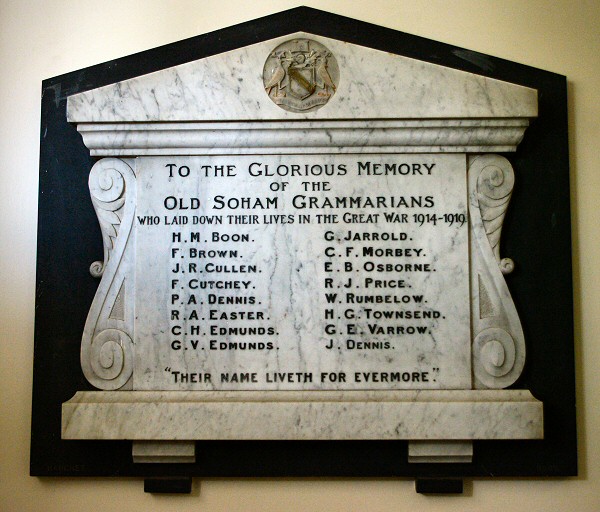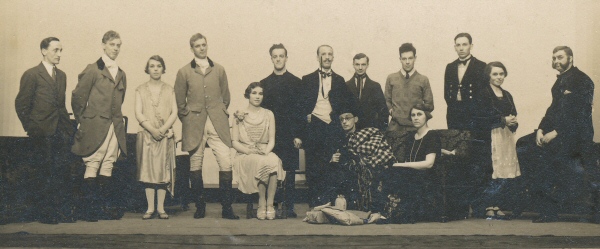this page contains many large images so please allow time for it to download if you have a slow connection
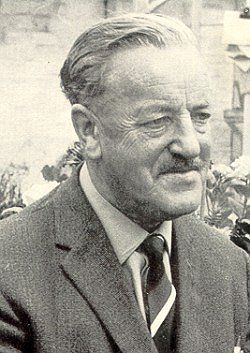 |
Ann has added some parts that she would have said on the night. She began at 9.50pmCan you all hear me through this machine? Can you hear me? [laughter]. When you were doing the Roll Call I wondered when it would come to me I thought Iíll say Ann Jarman 1938 and that will do Ö. but apparently I am not allowed to do that! (I would like to take this opportunity to pay tribute to the late Roger Lane, who did so much for the Old Boys until ill health prevented him from continuing. I have known Roger and his wife Anne for a very long time.) I would like to talk a bit about my father, who I believe was a very great person. We also thought you might like to know about the history of Beechurst, which you probably donít know about. |
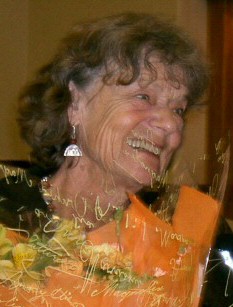 Ann Jarman taken at the 2008 Dinner |
My talk is based on a collection of photographs from my sister Mary and myself and includes our Morbey and Ford grandparents.
First of all a few notes about our connection with these buildings.
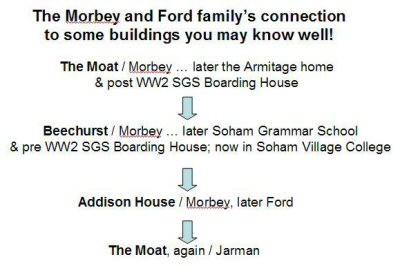
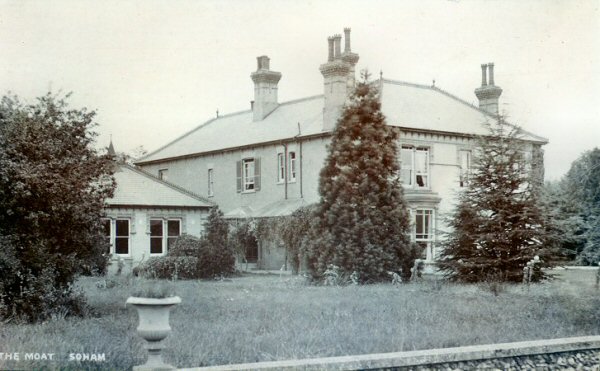
The Moat, date unknown: via Mary Wallis
This is an old photo of The Moat, in which we live now. Roddy [Armitage] where are you? How very nice that you are here. Was it like this in your time? [Very much so]. Itís a bit different now, those trees have fallen down and itís now covered in creepers and various things.
This is the house my grandfather, Charles Morbey [1856-1938], lived in when he came to Soham in about the 1880s. He was quite a lad really. His father was Head Groom to Lord Manvers, who lived at Holme Pierrepont Hall near Nottingham. He thought my grandfather was rather bright, which I think he was, and he sent him to school - I think it was Oundle - but my grandfather didnít think very much of that school, so he ran away.
Charles was a very good horseman, so he ran to Newmarket and became a jockey. He did very well. He gave up riding quite soon but he started to train horses and then to own them; he started buying quite a lot of property. I donít know why. He was quite a gambler, both on the horses and on cards.
He became very tied up with Lily Langtry, Iím not sure quite how 'tied up' [laughter].
Lily Langtry gave my grandmother a wonderful present. It was the most amazing box of red leather, lined with purple silk, there were powder brushes, combs, mirrors and all sorts of things all in silver gilt. This present was put under a bed and it didnít emerge until when I was quite a small child - my parents were then living in Addison House, at the end of what was then the School drive. My mother produced this box and said ďI think itís about time we had this out now.Ē Her mother, Annie, would never let it be displayed because she wanted nothing to do with Ďthat womaní in her house. Weíve got it now (deposited securely) - itís great fun.
My grandfather had quite a riotous life at the Moat. Edward VII didnít actually come to The Moat but my grandfather was a very good shot, he used to shoot at Sandringham with him.
He bought land all over the place including Hasse - which is now Greensí, Brandon Hall - a wonderful Queen Anne House in Suffolk, where the whole family used go in the winter with horses and carriages and spend the winter there for the shooting. He bought Saxham Hall [now demolished?] from which he removed a marble fireplace which is now in Beechurst in one of the rooms facing the Lawn. I donít know what the heritage people would say about that now! It was an Adam fireplace.
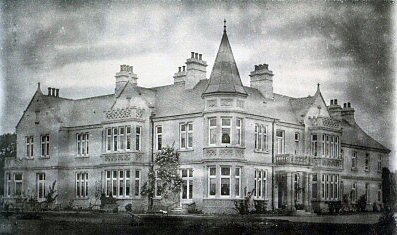
Beechurst, when the home of the Morbey family 1901-25:
ĎMorbeyís Follyí: via Mary Wallis
He had quite a life. At the end of the [nineteenth] century he decided he wanted a bigger house. Some people said he did it for a bet; other people said he did it just for fun - he wanted a bigger and grander house, I donít know why he moved here. It might also have been because one of his little daughters at the age of two was drowned in the lily pond at The Moat, something which obviously saddened them very much for their whole lives.
Beechurst was built and the family moved in in 1901.
Here are a few photographs of it when it was the home of my mother Winifred Mary Morbey [b1897]:
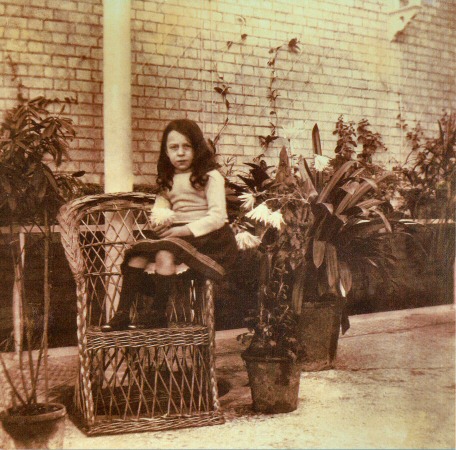
Miss Winifred Morbey, later Mrs Ford, in the Conservatory
This is my mother as a very little girl in the Conservatory which many of you will remember as the old Assembly Hall.
Sheís looking rather cross. One of her jobs was to tend some of the plants with dilute milk every day to keep them healthy - in particular a waxy plant, I canít remember the name.
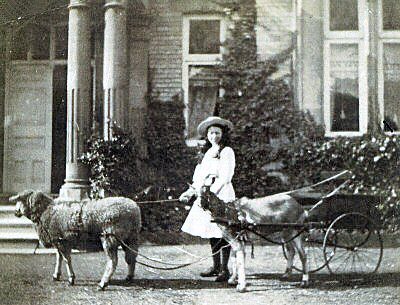
Miss Winifred Morbey with her lamb and goat cart at the entrance to
Beechurst: via Ann Jarman
Here she is again, rather a different photograph from all the school sporty photographs we see.
She is with her lamb and goat: they were, originally, called Lamb and Billy.
She used to gallop round the fields and the Lawn with them, totally out of control.
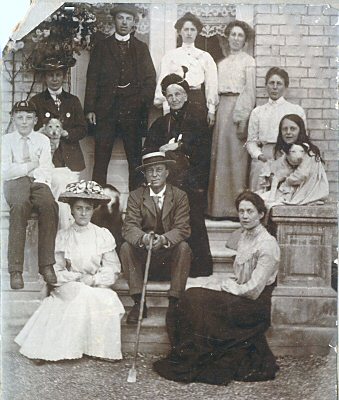
A Morbey family group at Beechurst and the French doors opening on to
the Lawn.
Winifred is holding Gyp on right: via Ann Jarman
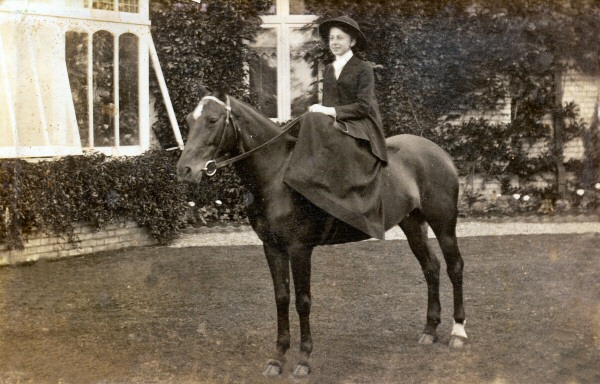
Winifred on Fairy, near the Conservatory: via Ann Jarman
Here is my mother again with her pony Fairy, an ex-polo pony, who is buried in the Old Orchard - though he may have been dug up by the Quinns or the Askems or the Scotts - together with two dogs and a butterfly my mother told me [laughter].

Winifred with her mother, Annie (nťe Jugg): via Ann Jarman
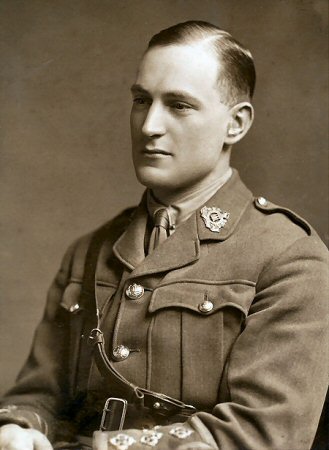
Captain Charles
Frederick William Morbey - Fritz
7th (Service) Bn, Suffolk Regt. Wounded at Loos 1915. Killed in
Action carrying a captured machine gun
when returning from a raid at Monchy 9 April 1917: via Ann Jarman
This is another brother of my mother, my uncle Fritz as we called him, though of course I never knew him for he was killed in the First World War. I think he was a wonderfully kind man. He is buried in Monchy.
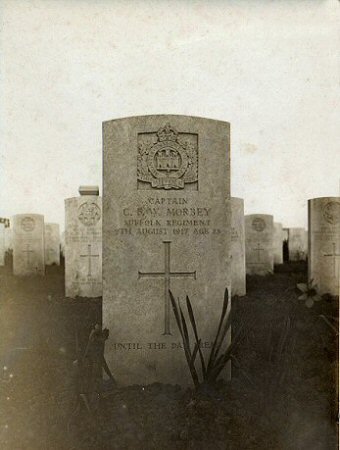
Fritz's headstone in Monchy Cemetery: via Ann Jarman
Fritz was a Grammarian and so is on this memorial which I think was in the Old Grammar School and then brought to Beechurst and is still here now.
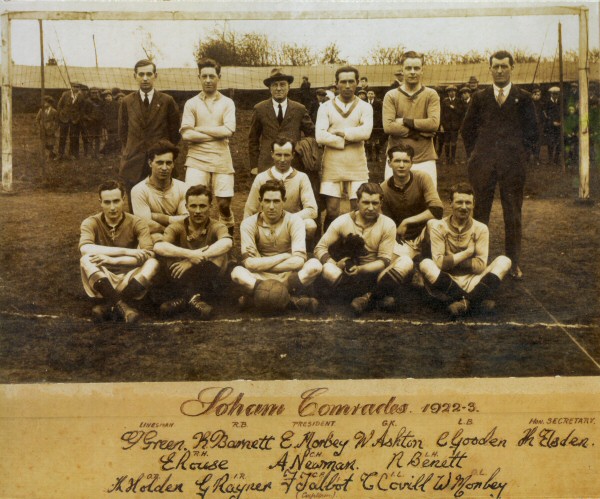
Soham Comrades Football team 1922-23: via Ann Jarman
Here is my grandfather with the Soham Comrades Football team, shortly before he went totally broke. He was also a County Councillor, a Parish Councillor and all sorts of things.
He was also Chairman of the local Conservative Club, which my father was later on. He used to have a friend called Ringer Chivers who lived at the end of East Fen Common, a great big burly man. Ringer always stood at the back of the Conservative Hall and if there were any hecklers my grandfather would just lift his finger and Ringer would pick them up by the scruff of the neck and remove them to the Brook Dam which wasnít far away and duck them under the water for some while until they calmed down. I donít think my father had those tactics when he was chairman.
Now for my father's family.
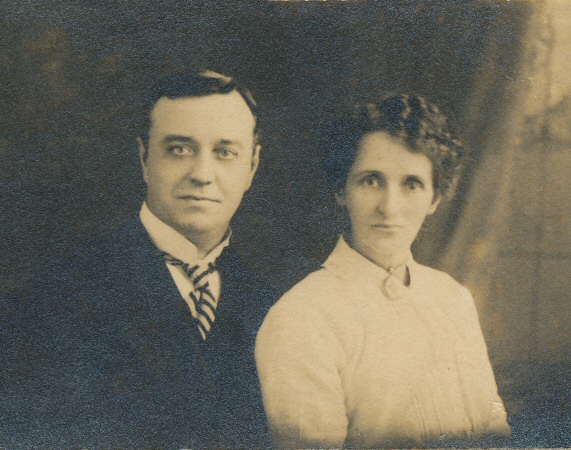
Charles and Flora Ford: via Mary Wallis
These are my fatherís parents. He came from a quite
humble background in Liverpool.
I think you can see quite a bit of my father in my grandfather there.
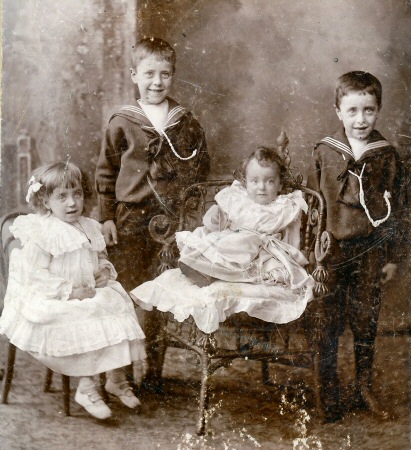
Here is my father in a dress, as they did for a little boy - he didnít
like this photograph very much [laughter].
Some Ford children: Flora, Harold, CJF, Eric: c1903: via Mary Wallis
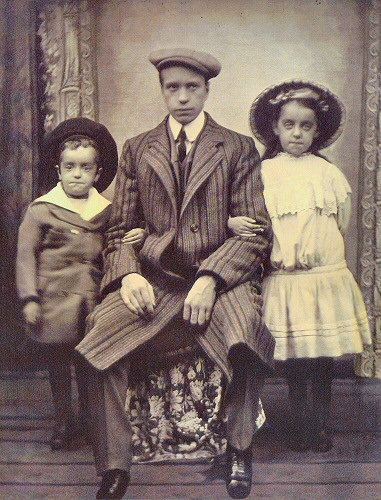
Here my father is on the left, Aunt Flora on the right and Eric, I
think, in the middle.
via Ann Jarman
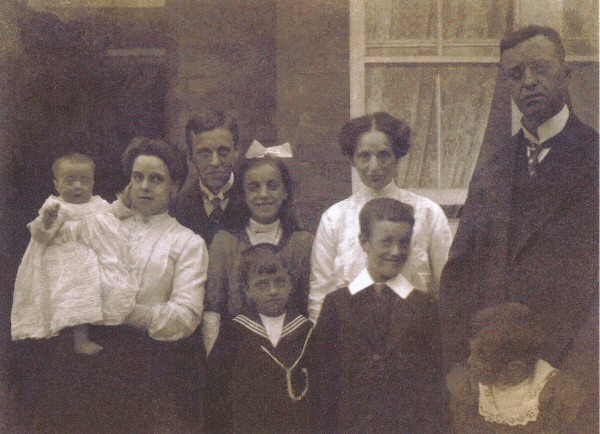
He was one of a family of seven, three of whom managed to go to the Holt
Grammar School in Liverpool.
They did jolly well. My father is the child with the big white
collar.
via Mary Wallis
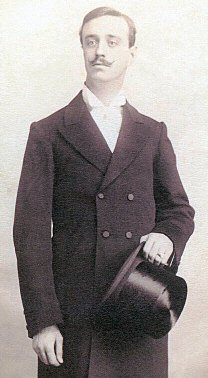
At one time it was thought this was my father in Pygmalion.
It seems it was his father, in a production in Birmingham. My father, as
we shall see, also did some acting.
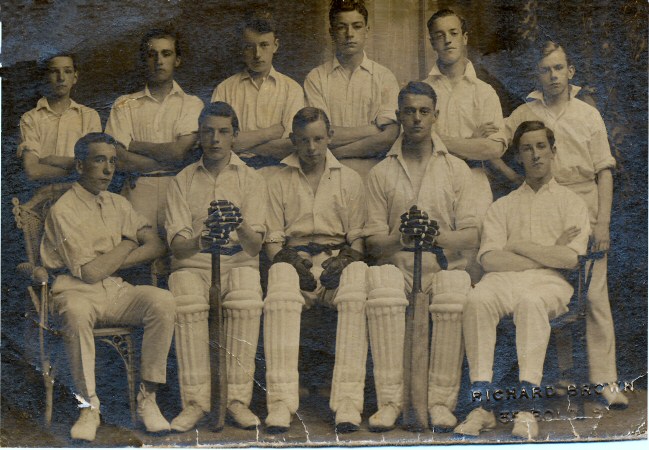
The cricketer: Holt School, Childwall, Liverpool: CJF 2nd R, back row:
via Mary Wallis
Here he is in a cricket team. He was very keen on cricket. I donít know if any of you would remember but he was responsible for creating the cricket square here on the playing field. He used to have an old roller, I donít know if you remember that roller [laughter]. Some of you might remember it had to be pushed backwards and forwards over the cricket square. Did my father do it as well? [merriment]. Anyway the roller is still there and is a meeting point for the young of Soham on Friday and Saturday nights now.
Do any of you remember Vivian Bobby? They were playing a school match, I canít remember against which school. Anyway the scores were very close. Someone on the opposing team did a great swipe and it was going to be a boundary but could have been stopped. The ball was near Vivian and he ran for it but as he did so his cap fell off. My father said ďDo you know what he did? Instead of going after the ball he stopped and picked up his cap.Ē [laughter]. Poor Vivian was never forgiven for that.

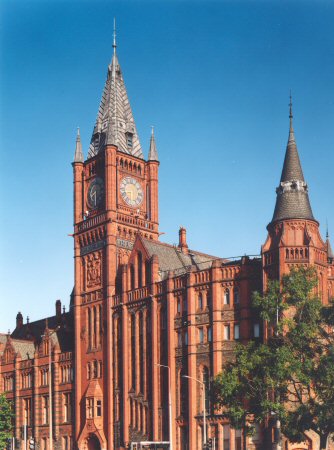
My father went to the University of Liverpool. It was
quite a strain financially for him to go there.
One of his brothers, Uncle Harold, who was much older and in the
Merchant Navy paid for him most of the time.
For the rest, my father worked in the docks, which I think he thoroughly enjoyed.
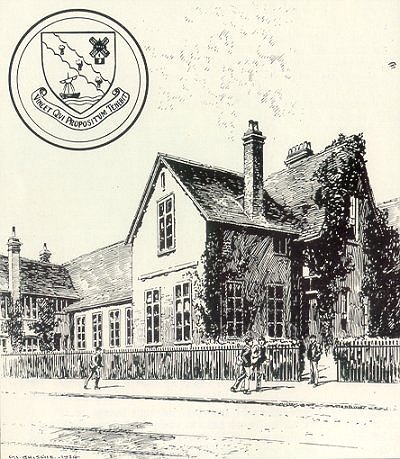
When he graduated - I canít remember the date ... I hear my father coughing, do you remember he had a nervous cough when somebody made a mistake. I did hear it quite frequently!
He came down to the Old Grammar School in Churchgate Street a few months before it moved to Beechurst.
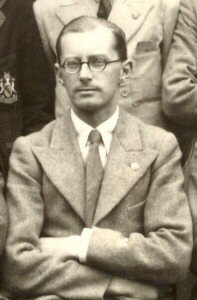 Mr Cecil Crouch, Music c1926-45 |
|
He took part in many, many productions usually organised by fellow member of staff, Mr Crouch, who shared digs with him and was his Best Man and a very great friend. It was quite surprising to me that he was such an actor.
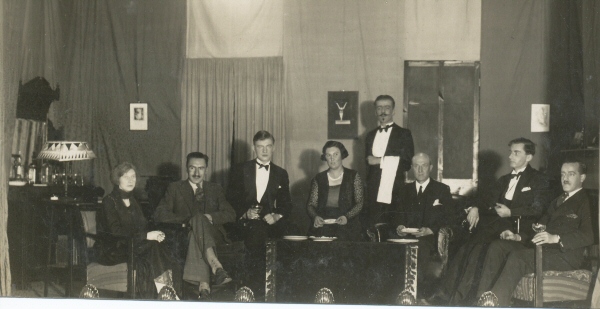
Soham Players 1930 production, The Rope. CJF on
extreme right: via Mary Wallis
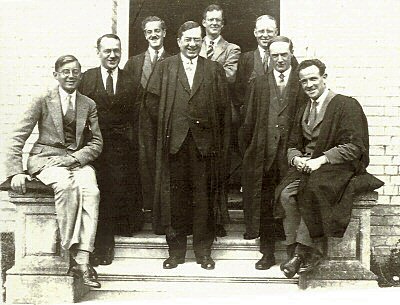
Mr Platt & some staff at Beechurst, date?
L-R: Mr CW Crouch - 2 - Mr CJ Ford - Mr JC Platt - 5 - Mr LG Johnson -
Mr GL Hunt - Mr RL Thomas
[Mr TL Riley, not shown, arrived 1929]
Here are some of the staff at Beechurst. Mr Platt I didnít know. Mr Johnson, Mr Riley, Mr Hunt and Mr Thomas were all people who were very familiar to me as a child as I grew up with them always being around.
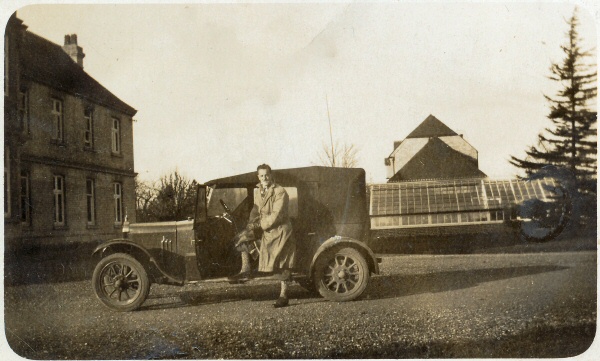
His first car: via Mary Wallis
This is a lovely picture of my father with his first car - does anyone know what it was? I donít think you can see there but he had check socks and plus-fours.
He always told the story of going to fetch it from Cambridge. He had never been behind a steering wheel in his life. The car was waiting for him in Cambridge and so he went to collect it, got behind the steering wheel and drove home. He didnít need a single lesson, he said, didnít run anybody over, perfectly straightforward [laughter]. He was jolly proud of it.
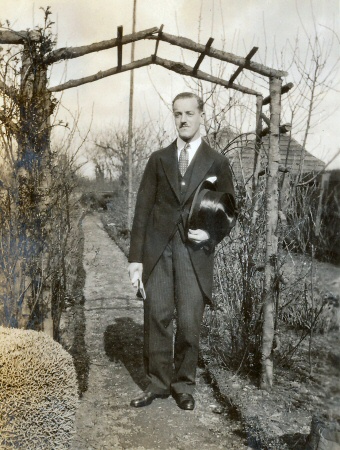
CJF about to leave for wedding from digs at Mrs Banyardís, Hursley,
Hall Lane, Soham 31 Dec 1932
via Mary Wallis
Hereís my father on his wedding day. He met my mother at a Badminton Club that Soham had in those days, they both loved the game. Fred [Eden] - you said that there was some story of Crouch pursuing my mother as well?
Fred: "In 1947 there was a school trip to an International at Wembley. I was sitting next to Mr Ford. He told me that he and Mr Crouch used to regularly hire a punt from Harry Iggy Sizer at the Brook Dam, and take it along the Soham Lode (River Snail). He said "We used to go along and would hope to get a glimpse of Miss Winifred Morbey. We vied for her attention".
Fred recalls that CJF then stuck his chin out and chortled "I won!"I donít think he might want me to mention about his name, the ceiling might fall down.
Everybody here I think called him Charlie or Chas, but his real name was Cecil and he hated it. When he came to Soham he told everybody it was John. When he shared digs with Mr Crouch at Mrs Banyardís in Hall Street, Crouch was a Cecil too so this was a good excuse to get rid of the Cecil and just stick to the John. I was always surprised when people would talk to me about Charlie Ford. He was never called Cecil except by his Liverpool family.
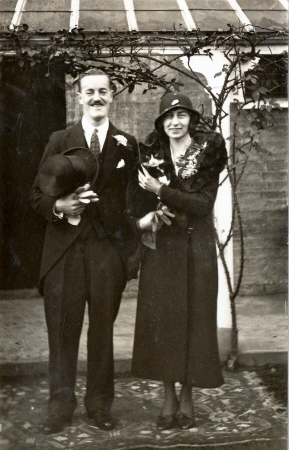
The happy couple at Addison House 31 Dec 1932. Cecil Crouch was the Best
Man.
The Fords went to live at Wyncote, Kingís Parade: via Mary
Wallis
Here are my parents, just married, at Addison House. My mother, inevitably, carrying an animal: my father looking immensely proud. They didnít have a white wedding, money was a bit short anyway. My Ford grandfather had died about six months earlier so they wanted quite a quiet wedding.
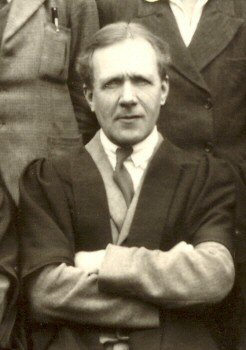

My fatherís Headmaster after Mr Platt was Mr Neill. I was only about one year old when he left.
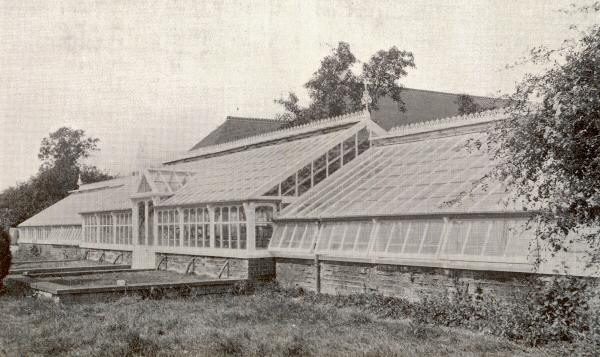
'Greenhouses And Rural Science Laboratory' - from a 1930s School
Prospectus
My father absolutely adored the greenhouses. Do you remember Mr Crick? He was the Gardener [as he had been for my Morbey grandfather]. He very graciously allowed my father to use one section of the greenhouse for his chrysanthemums. My sister Mary had a great passion for Mr Crick. I donít know whether you remember but he had enormous eyebrows. He was an extremely severe man. She just willed herself to have big eyebrows like him. She has got quite hairy eyebrows now [laughter].
Mary was his favourite, he taught her quite a lot about gardening. I donít know if you remember, there was a big vine in one of those greenhouses. We were never allowed to have any of the grapes. I remember when Mary had measles, he sent over one bunch of grapes for her and she has never forgotten that.
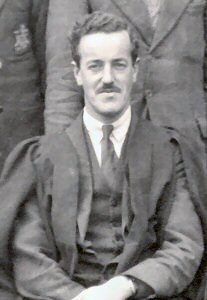 1935 |
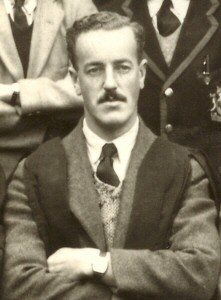 1937 |
My father before I knew him ... he really didnít change very much.
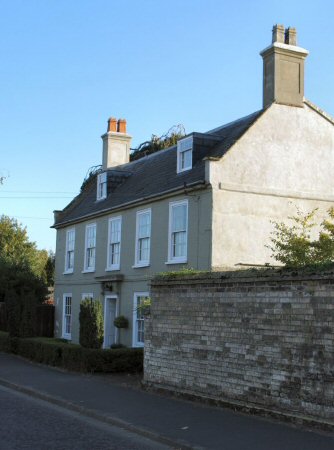
Addison
House as it is today
My grandparents Charlie and Annie Morbey moved to Addison House in about 1926.
My grandfather had gone broke. He amassed enormous sums of money and he lost it, we donít really know how. I remember being told of my uncles being called back from London. They met him in the Station Hotel. My grandfather lit a cigar, put his feet on the mantelpiece and said ďIím afraid I have got something to tell youĒ. ďWhatís that guvnor?Ē- they always called him that - ďIím afraid Iím broke. The only trouble is ... your motherís not too pleased." [laughter]. And that was that.
They moved into Addison House - which my motherís family had owned - for the rest of their lives.
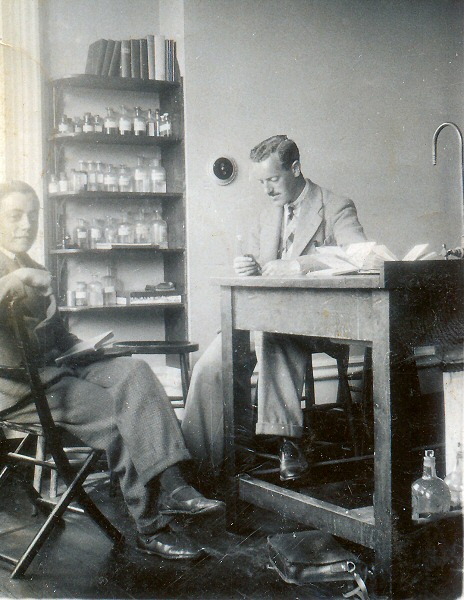
via Mary Wallis
Here is my father in the Chemistry Lab at Beechurst, which I think was on the right hand side overlooking the Lawn. It had a strange smell, I donít know if you remember that?
I was told that when they moved from Churchgate Street to Beechurst the boys were made to carry things including bottles of acid. Two boys, very stupidly, my father said, dropped bottles of sulphuric acid. One of them sat in it which made my father extremely cross because he had to buy him a new pair of trousers. [laughter].
[Fred Eden added that his brother Jack recalled being involved in this incident. It is mentioned in the School History:
The removal was completed at the end of October, in the middle of the Autumn Term 1926. This impression of the move is given by Mr. Claude Greensmith:
"The move was accomplished in a most economical manner as we boys did all our own dirty work. I have distinct recollections of carrying two Winchesters of sulphuric acid through the Churchyard and down the alley by the new Recreation Ground to Beechurst over the bridge across the river and down the Moat Drive." The latter part of this route was later to become very familiar to boys travelling daily from Cambridge by train.
Mr. C. J. Ford recalls that:
"during the move one of the boys slipped and sat in a pool of concentrated sulphuric acid with disastrous results to his trousers but fortunately without too serious consequences to his person."]My father was a very gentle person but I remember Tinker Wells and John Neville both saying that he used to whack them with Bunsen burner tubing if they hadnít done their homework or if they arrived late [laughter].
(He very rarely lost his temper, however he was deeply intolerant of bad manners, as some found out to their cost.)
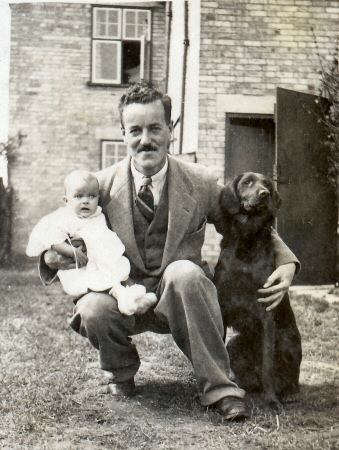
via Mary Wallis
We lived in Kingís Parade until my grandparents died. This is of my father with my sister Mary and a very favourite Red Setter, Patricia.
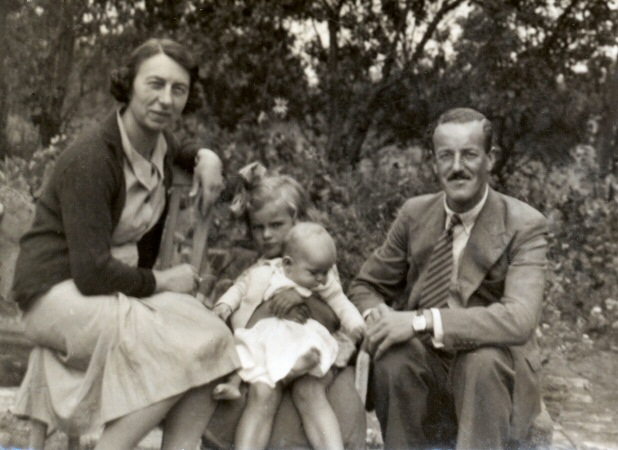
My parents again with Mary and me, now at Addison House: via Mary Wallis
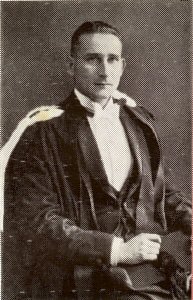
Wartime Head Mr Stanley Stubbs, 1940-Jan 1945
I remember Mr Stubbs quite well, I used to play with his daughter Anne.
I remember both of us stunning a frog once: apparently Anne said to me ďWhat do frogs do?Ē I replied ďNothing.Ē .... which my father wouldnít have liked too much.

ARP Service: crater at Soham following ordnance train explosion 2 June
1944
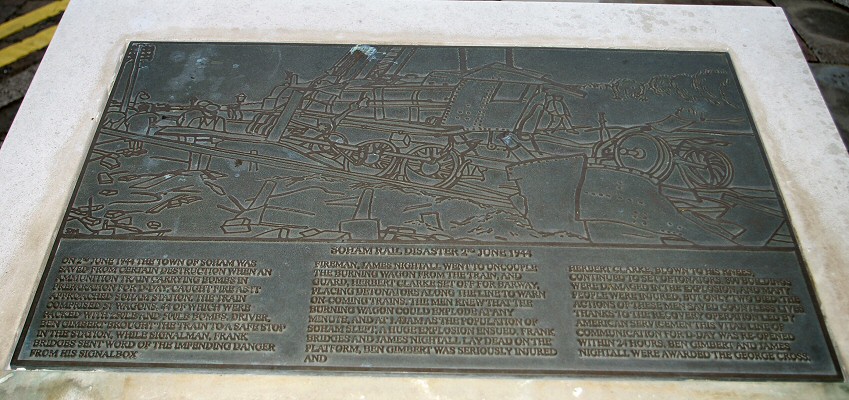
Commemorative plaque near Soham's War Memorial
Bluey: This was when there was the explosion at Soham station during the war. My father was the head of the local ARP section.
I remember it very well - the most enormous blast. My father leapt out of bed. He had blue pyjamas and he put his ARP uniform on top of them. He came into our bedroom and said he had to had to go and off he went on his bike. I was so embarrassed, because two inches of blue pyjamas protruded below his ARP navy-blue trousers. I thought he would never be able to live this down. I think he had more important things on his mind.
I remember him saying he biked his way up to the station and the whole street was covered in glass, but he didnít get a puncture.
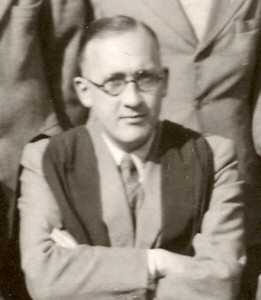
1945 - Edward Armitage arrives.
from the 1946 School photo
I remember when Mr Armitage arrived and the change-over. My father was very impressed because Mr Armitage always ran up the front steps of the school whereas Mr Stubbs used to walk quite slowly. Your father running up very briskly, Roddy, thatís one of the first things I remember about him.
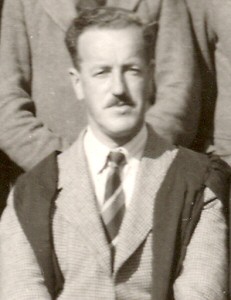 1946 |
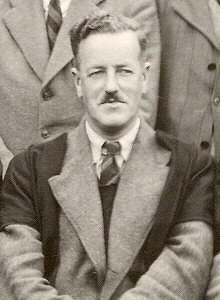 1949 |
At about this time I would have been about 8 or 9. I remember a production of The Tempest [16 July 1947] in the garden. I donít know produced it [Mr IR Bell]. Do you remember Philip Bobby climbing the Scots Pine in the corner and singing Where The Bee Sucks from high, high up? I donít think Health & Safety would approve these days! [someone adds ďI remember the background music was Sibeliusí Finlandia.Ē]
There was a Weeping Ash, there is still a bit of it there, which was Prosperoís cave, Whoever was Prospero [Mr Jack Symmons] had an extremely bad wig and you could see the line between the wig and his head. I thought how absurd, Mr Johnson could have done this because he was bald already [laughter]. I also remember Miranda [Hartley] had a horrible yellow wig and a very hoarse voice. I think there were quite a few productions outside.
That bit of the garden reminds me of my uncles. Do you remember there used to be a path alongside the orchard where Peter Scott now lives and a ditch on one side. It was called The Nut Walk. A row of hazel trees is still there on one side and walnut trees on the other. My uncles used to pinch my grandfatherís cigars and go down and smoke them in what was a little summer house at the bottom there. My mother, who was very much the youngest sister, was on guard at the end of the path. She had to whistle if my grandfather should be anywhere near.
She couldnít whistle [laughter].
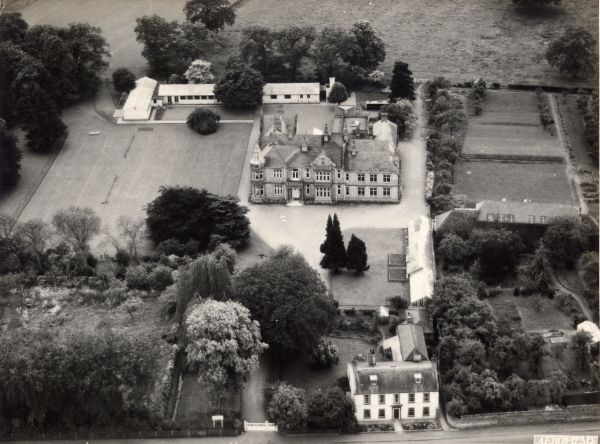
Living on the job - Addison House and Soham Grammar School, early
1950s
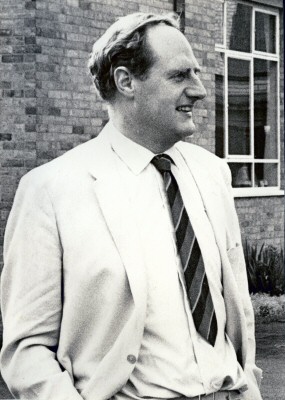
Albert Lawrance - Bert - Punch
Mr Lawrance first came to the school in 1952.
[In 1972 he was Warden of the Village College when the Grammar School merged with it on going comprehensive.] My father used to see lots of lights on late, late at night, night after night. He eventually went over to see what was happening. It was Bert Lawrance working late and my father gave him a great lecture on not working too much out of College hours.
He could talk, he used to go into school every night, I remember.
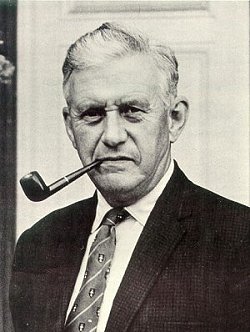
Mr Thomas Riley - Luke - Slug
Mr Riley, I remember him well. His classroom faced my bedroom in Addison House. When I was ill - in those days you were made to stay in bed for ages - I can remember hearing French irregular verbs being yelled out of the window [laughter]. Iíve always enjoyed French ever since.
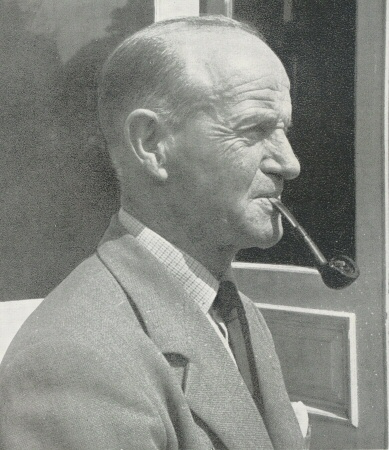
Mr Rees Thomas - Taffy
Uncle Tom -Taffy. How cross he used to get - the school didnít play rugger [from shortly after Edward Armitage arrived]. He thought this was quite appalling and nearly gave in his notice. Apparently he taught until he was 70.
He was able to do that, he said, because he stood on his head every day! I only heard that tonight.
Carin, can you stand on your head?
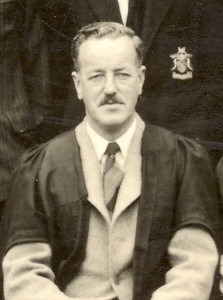 1952 |
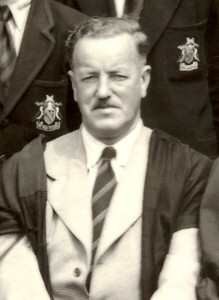 1954 |
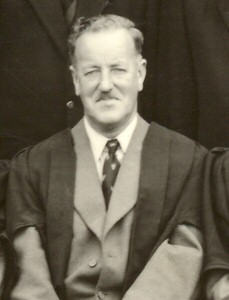 1956 |
More pictures of my father taken from school photos.
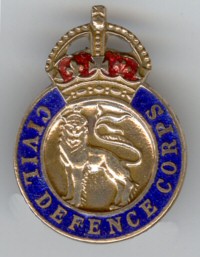
CD Corps badge
After being in the ARP during the war he continued in Civil Defence and ended up as Sector Warden. He used to go once a week to a pill-box on Qua Fen Common. It was my job to ring him up. He was never very good at waking up so I had to ring him up in the morning - Soham 66, I think the number was. I had to do it through the Operator, we had a phone with a separate earpiece.
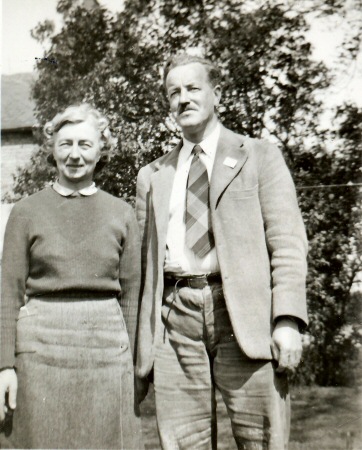 |
 |
My parents much later, my mother with another cat and a Red Setter. We always had Red Setters and they were all pretty good, but one was completely barmy. Here is what Warwick Ellis, PE 63-66 wrote:
ďI still remember clearly (though the teeth marks soon healed) arriving late to school one morning and pedalling furiously up the drive. John Ford lived in the gatehouse and owned a Red Setter which was mad - absolutely un-hinged. Seeing me flying past it leapt a four foot fence, knocked me off my bike, seized my shoulder in its teeth and shook me.
John Ford's apology was so fulsome and gentlemanly, as he always was, that I had no thought to complain and almost felt responsible for the incident.Ē
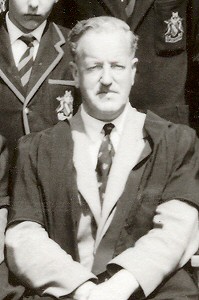 1960 |
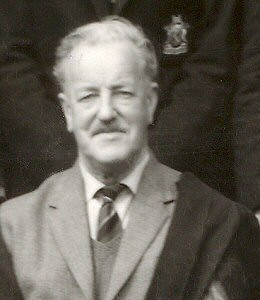 1965 |
School photographs again - the last ones.
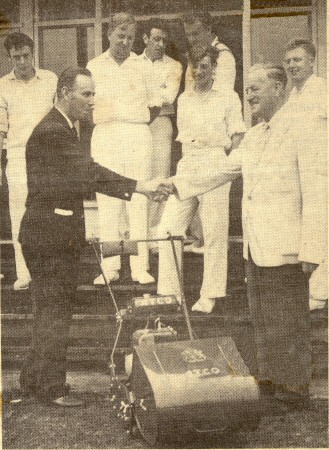 Mowing off into the Sunset? 1964 |
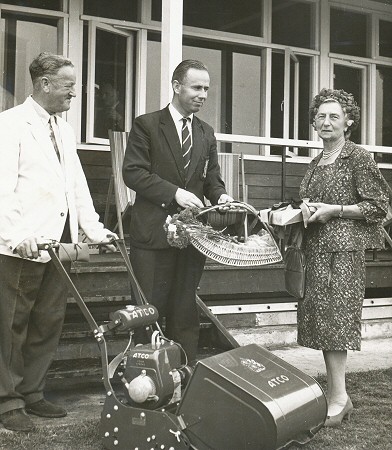 via Glyn Murfet, provided since the Dinner |
This was my fatherís leaving present. Every week he used to pinch the schoolís lawnmower to do our lawn. I think they thought he should have one. We still have it somewhere.
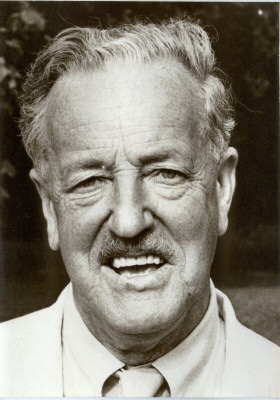
This is a later photo, taken by Frank at a School FÍte in 1968. My
father was still teaching part-time I think.
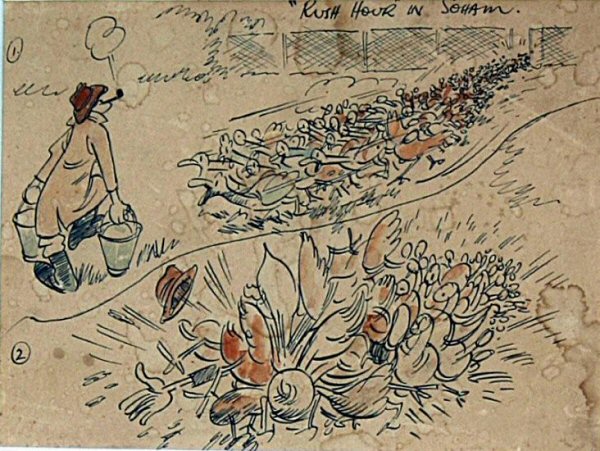
via Mary Wallis
This is something you may remember seeing. We used to have a field opposite Addison House, which is now built on. At the far end we had an orchard and kept chickens, duck and geese, and there was my fatherís vegetable garden. Every morning before school he used to go over carrying one bucket of corn and one bucket of water - there was no water over there. All the fowl used come and meet him. He wore his wellingtons and old coat and always had his pipe.
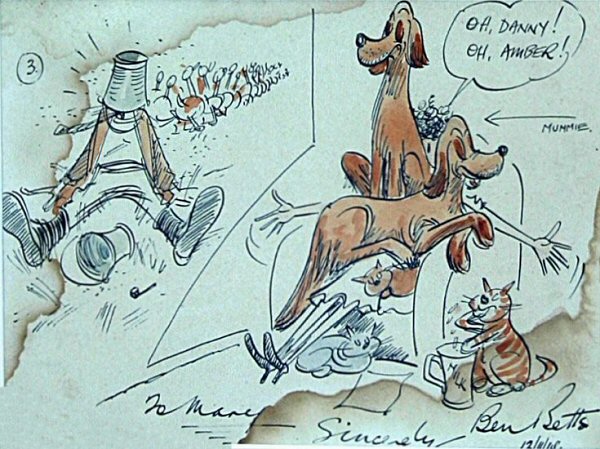
Red Setters totally dominated my motherís life, sitting on top of her in
the sitting room.
A neighbour of ours who was a cartoonist (for the Daily Mail I think) did these cartoons for my sisterís autograph book - I think they are really very good indeed.
(I wanted to say something of his passions and his outlook:
he had a great love of Bridge. He used to play regularly with Stuart Saunders, Roy Fernie who was a bank manager in Ely, and some of the masters from Kings Ely. He disapproved of women playing, he didn't think that they were serious enough: my mother had to give up playing for that reason ...
he also loved Football. He was a great supporter of Norwich City and used to go to many of their home games with Derek Bradfield from Brittens Garage and sometimes with Walter Gidney.
he also supported Everton. He had connections with Jack Sharp who was one of their most famous players and who became a director of the club. If my father was visiting his family in Liverpool he used to enjoy watching games from the directors' box at Goodison Park.
although my father was a Tory, he was totally classless in his outlook - he was the same to everyone.)
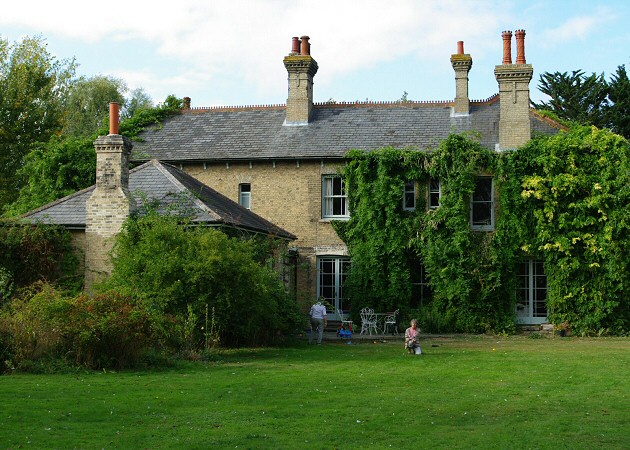
The Moat, September 2009
Here is The Moat today. Roddy, Iím so sorry itís covered in creepers. They are about to be cut back. When we bought it there was a clump of Wisteria on one side of the French windows, and on the other side I think your mother said it was a type of American Pillar Rose. They seemed totally dead but we gave them buckets of water and masses of horse manure and thatís the result. Now they are higher, right over the roof.
When we bought The Moat it was in a terrible state. It had been a sort of youth club. It was quite appalling. I used to go to Yoga lessons there and I used to think 'poor old house, this is desperate'. Fireplaces had been ripped out, cornicing had gone, there were great fire-screens everywhere.
I thought what fun it would be to try and make it into a home again.
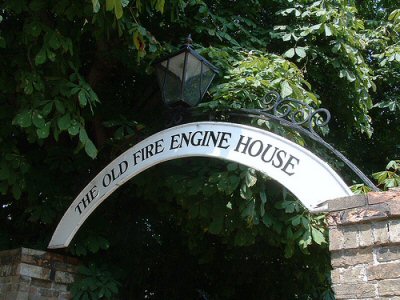 |
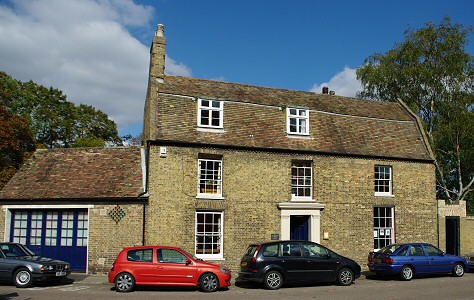 |
This is where I work, the Old Fire Engine House in Ely, which we started in 1968. Everybody thought, probably rightly, that it was a crazy thing to do. My parents were furious, I remember, because I had been a Civil Servant with pension prospects and all that sort of stuff. The thought that we were going to open a restaurant of which none of us had any experience whatsoever was crazy. I think it probably was quite crazy.
It was very important financially to see how we were going, how much money we were losing. We did a monthly analysis worked out by my father of how much we had taken and how much we had spent. And we did a stock-take every month of the cellar and the store room. My father was totally meticulous. You couldnít say 9ĺ pints of milk was 10 pints. Roughly wasnít good enough, it had to be absolutely correct. Valerie, Chris Bentís wife, did a lot of the secretarial work and she and my father used to have races sometimes. He very much scorned any kind of adding machine: she would add a column of figures up with an adding machine and my father would do it in his head. I think she might have been rather kind and let him win.
He really enjoyed it, he said he had never used any of his skills practically before. As a Ďwageí he had a bottle of J&B Whiskey and he and my mother used to come for lunch on Thursdays. I remember seeing the larder in Addison House, there were these rows of whiskey bottles - he said it gave him a 'very comfortable feeling'. [laughter].
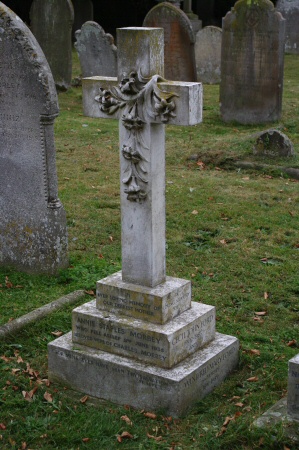 |
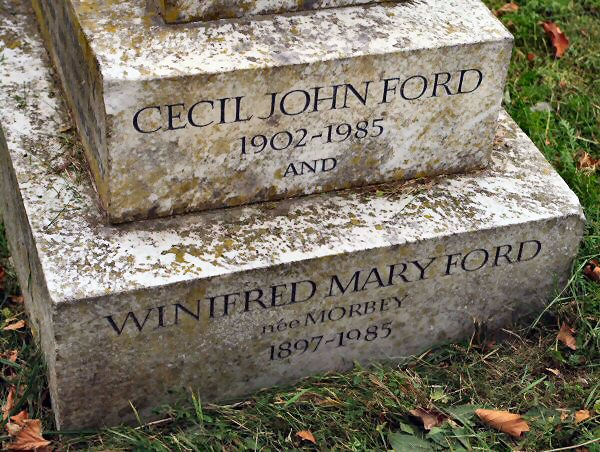 |
This is my parentsí gravestone in Soham Cemetery, with my Morbey grandparents.
My father died on 5th July 1985 and my mother followed him exactly two weeks later, which was well planned on her part.
So thatís CJ Ford [prolonged applause].
see also Mr Ford's page
back to 2009 Dinner
images: from SG archive or Haslam, unless otherwise stated
If you have memories of Mr & Mrs Ford, please contact
the editor.
page created 9 Oct 2009: last updated 10 Jun 2010
